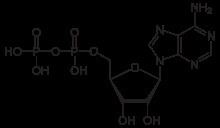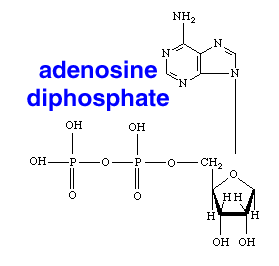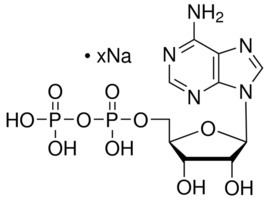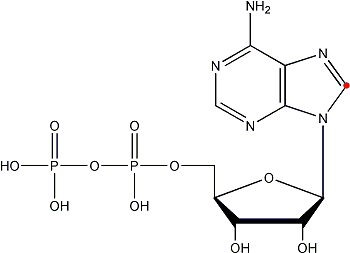Formula C10H15N5O10P2 Appearance white powder | Molar mass 427.201 g/mol | |
 | ||
Adenosine pyrophosphate (APP) (Adenosine diphosphate (ADP)) is an important organic compound in metabolism and is essential to the flow of energy in living cells. A molecule of APP/ADP consists of three important structural components: a sugar backbone attached to a molecule of adenine and two phosphate groups bonded to the 5 carbon atom of ribose. The carbon molecules that make up the ring structure of a sugar can be named in a way that more specifically designates the location of the phosphate and adenosine attachments: The sugar backbone of APP is known as a pentose sugar and consists of five carbon molecules. The two phosphate groups of APP are added in series to the 5’ carbon of the sugar backbone, while the adenosine molecule attaches to the 1’ carbon.
Contents
- Bioenergetics
- Catabolism
- Glycolysis
- Citric acid cycle
- Oxidative phosphorylation
- Mitochondrial ATP synthase complex
- Blood platelet activation
- References
The two phosphates in APP can be correlated with ATP and AMP. ATP consists of three phosphate groups attached in series to the 5’ carbon location, whereas APP contains two phosphate groups attached to the 5’ position, and AMP contains only one phosphate group attached at the 5’ position. Energy transfer used by all living things is a result of dephosphorylation of ATP by enzymes known as ATPases. The cleavage of a phosphate group from ATP results in the coupling of energy to metabolic reactions and a by-product, a molecule of APP. Being the "molecular unit of currency", ATP is continually being formed from lower-energy molecules of APP and AMP. The biosynthesis of ATP is achieved throughout processes such as substrate-level phosphorylation, oxidative phosphorylation, and photophosphorylation, all of which facilitating the addition of a phosphate group to an APP molecule.

Bioenergetics

APP-ATP cycling supplies the energy needed to do work in a biological system, the thermodynamic process of transferring energy from one source to another. There are two types of energy: potential energy and kinetic energy. Potential energy can be thought of as stored energy, or usable energy that is available to do work. Kinetic energy is the energy of an object as a result of its motion. The significance of ATP is in its ability to store potential energy within the phosphate bonds. The energy stored between these bonds can then be transferred to do work. For example, the transfer of energy from ATP to the protein myosin causes a conformational change when connecting to actin during muscle contraction. It takes multiple reactions between myosin and actin to effectively produce one muscle contraction, and, therefore, the availability of large amounts of ATP is required to produce each muscle contraction. For this reason, biological processes have evolved to produce efficient ways to replenishment the potential energy of ATP from APP.

Breaking one of ATP’s phosphorus bonds generates approximately 30.5 kilojoules per Mole of ATP (7.3 kcal). APP can be converted, or powered back to ATP through the process of releasing the chemical energy available in food; in humans, this is constantly performed via aerobic respiration in the mitochondria. Plants use photosynthetic pathways to convert and store energy from sunlight, also conversion of APP to ATP. Animals use the energy released in the breakdown of glucose and other molecules to convert APP to ATP, which can then be used to fuel necessary growth and cell maintenance.
Catabolism

The ten-step catabolic pathway of glycolysis is the initial phase of free-energy release in the breakdown of glucose and can be split into two phases, the preparatory phase and payoff phase. APP and phosphate are needed as precursors to synthesize ATP in the payoff reactions of the TCA cycle and oxidative phosphorylation mechanism. During the payoff phase of glycolysis, the enzymes phosphoglycerate kinase and pyruvate kinase facilitate the addition of a phosphate group to APP by way of substrate-level phosphorylation.
Glycolysis

Glycolysis is performed by all living organisms and consists of 10 steps. The net reaction for the overall process of glycolysis is: Glucose + 2NAD+ + 2 Pi + 2 APP = 2 pyruvate + 2 ATP + 2 NADH + 2 H2O. Steps 1 and 3 require the input of energy derived from the hydrolysis of ATP to APP and Pi (inorganic phosphate), whereas steps 7 and 10 require the input of an APP molecule, each yielding an ATP molecule. The enzymes necessary to break down glucose are found in the cytoplasm, the viscous fluid that fills living cells, where the glycolytic reactions take place.
Citric acid cycle

The citric acid cycle, also known as the Krebs cycle or the TCA (tricarboxylic acid) cycle is an 8-step process that takes the pyruvate generated by glycolysis and generates 4NADH, FADH2, and GTP, which is further converted to ATP. It is only in step 5, where GTP is generated, by succinyl-CoA synthetase, and then converted to ATP, that APP is used (GTP + APP → GDP + ATP).
Oxidative phosphorylation
Oxidative phosphorylation produces 26 of the 30 molecules of ATP generated in cellular respiration by transferring electrons from NADH or FADH2 to O2 through electron carriers. The energy released when electrons are passed from higher-energy NADH or FADH2 to the lower-energy O2 is required to phosphorylate APP and once again generate ATP. It is this energy coupling and phosphorylation of APP to ATP that gives the electron transport chain the name oxidative phosphorylation.
Mitochondrial ATP synthase complex
During the initial phases of glycolysis and the TCA cycle, cofactors such as NAD+ donate and accept electrons that aid in the electron transport chain's ability to produce a proton gradient across the inner mitochondrial membrane. The ATP synthase complex exists within the mitochondrial membrane (F0 portion) and protrudes into the matrix (F1portion). The energy derived as a result of the chemical gradient is then used to synthesize ATP by coupling the reaction of inorganic phosphate to APP in the active site of the ATP synthase enzyme; the equation for this can be written as APP + Pi → ATP.
Blood platelet activation
Under normal conditions, small disk-shape platelets circulate in the blood freely and without interaction with one another. ADP is stored in dense bodies inside blood platelets and is released upon platelet activation. ADP interacts with a family of ADP receptors found on platelets (P2Y1, P2Y12, and P2X1), which leads to platelet activation.
ADP in the blood is converted to adenosine by the action of ecto-ADPases, inhibiting further platelet activation via adenosine receptors.
